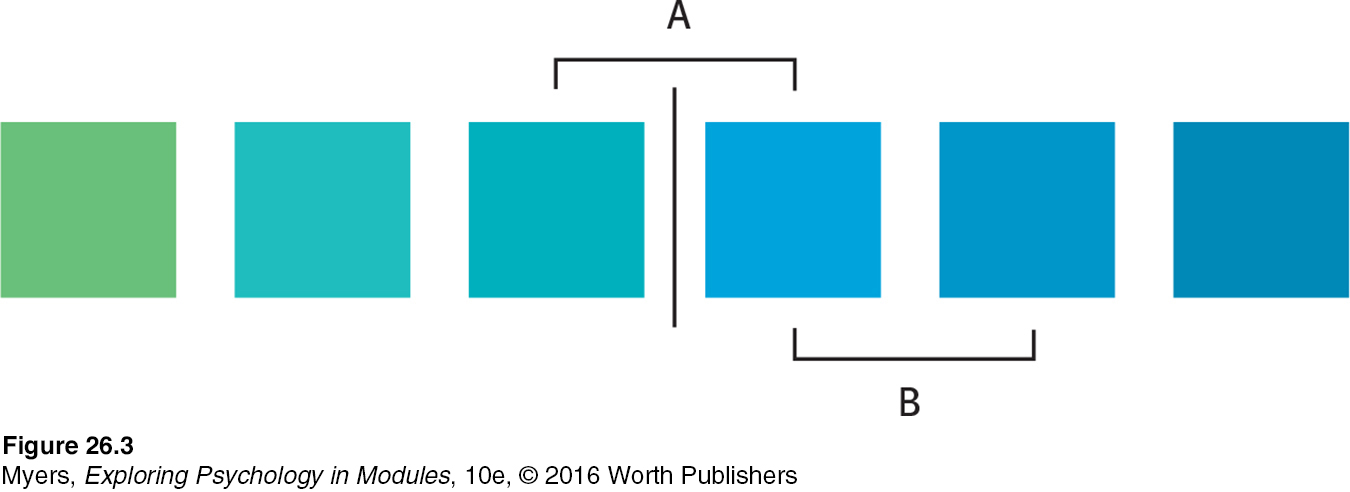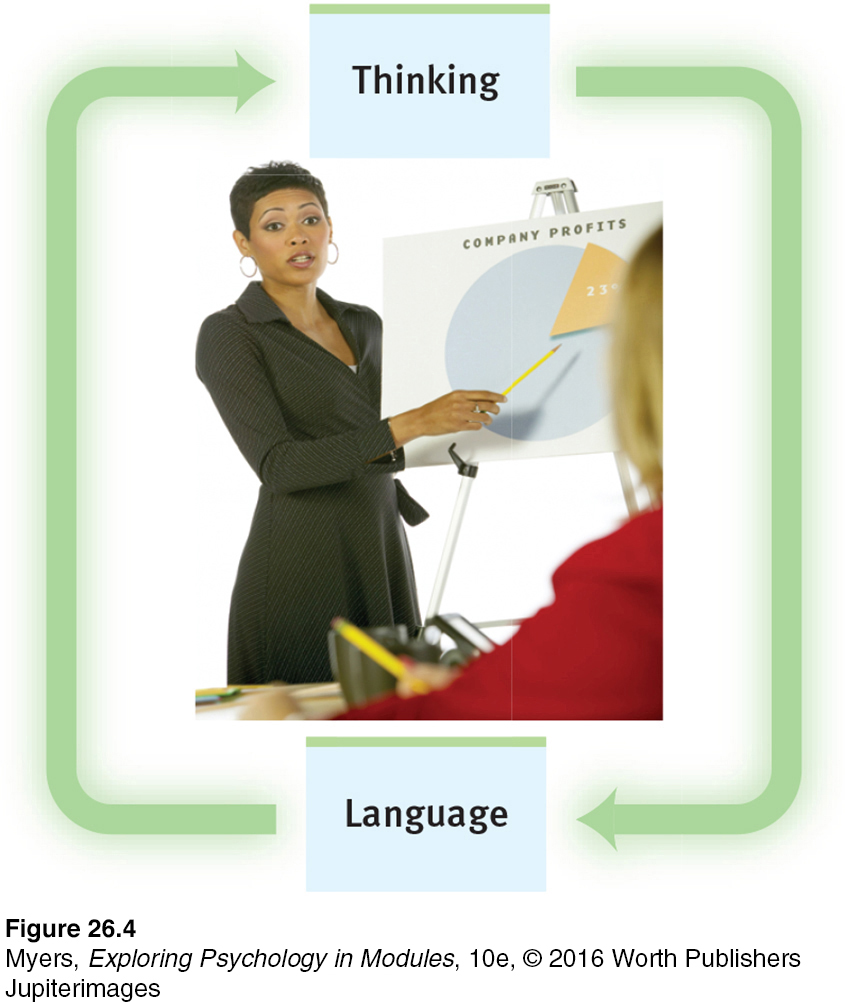26.5 Thinking and Language
26-
Thinking and language intricately intertwine. Asking which comes first is one of psychology’s chicken-
Language Influences Thinking
Linguist Benjamin Lee Whorf (1956) contended that “language itself shapes a [person’s] basic ideas.” The Hopi, who have no past tense for their verbs, could not readily think about the past, said Whorf.
linguistic determinism Whorf’s hypothesis that language determines the way we think.
Whorf’s linguistic determinism hypothesis is too extreme. We all think about things for which we have no words. (Can you think of a shade of blue you cannot name?) And we routinely have unsymbolized (wordless, imageless) thoughts, as when someone, watching two men carry a load of bricks, wondered whether the men would drop them (Heavey & Hurlburt, 2008; Hurlburt et al., 2013).
Nevertheless, to those who speak two dissimilar languages, such as English and Japanese, it seems obvious that a person may think differently in different languages (Brown, 1986). Unlike English, which has a rich vocabulary for self-
Depending on which emotion they want to express, bilingual people will often switch languages. “When my mom gets angry at me, she’ll speak in Mandarin,” explained one Chinese-
Our words may not determine what we think, but they do influence our thinking (Boroditsky, 2011). We use our language in forming categories. In Brazil, the isolated Piraha people have words for the numbers 1 and 2, but numbers above that are simply “many.” Thus, if shown 7 nuts in a row, they struggle to lay out the same number from their own pile (Gordon, 2004).
Words also influence our thinking about colors. Whether we live in New Mexico, New South Wales, or New Guinea, we see colors much the same, but we use our native language to classify and remember them (Davidoff, 2004; Roberson et al., 2004, 2005). Imagine viewing three colors and calling two of them “yellow” and one of them “blue.” Later you would likely recall the yellows as being more similar. But if you speak the language of Papua New Guinea’s Berinmo tribe, which has words for two different shades of yellow, you would more speedily perceive and better recall the variations between the two yellows. And if your language is Russian, which has distinct names for various shades of blue, such as goluboy and siniy, you might recall the yellows as more similar and remember the blue better. Words matter.

Perceived differences grow as we assign different names. On the color spectrum, blue blends into green—

Given words’ subtle influence on thinking, we do well to choose our words carefully. Is “A child learns language as he interacts with his caregivers” any different from “Children learn language as they interact with their caregivers”? Many studies have found that it is. When hearing the generic he (as in “the artist and his work”) people are more likely to picture a male (Henley, 1989; Ng, 1990). If he and his were truly gender free, we shouldn’t skip a beat when hearing that “man, like other mammals, nurses his young.”
To expand language is to expand the ability to think. Young children’s thinking develops hand in hand with their language (Gopnik & Meltzoff, 1986). Indeed, it is very difficult to think about or conceptualize certain abstract ideas (commitment, freedom, or rhyming) without language! And what is true for preschoolers is true for everyone: It pays to increase your word power. That’s why most textbooks, including this one, introduce new words—
“All words are pegs to hang ideas on.”
Henry Ward Beecher, Proverbs from Plymouth Pulpit, 1887
Increased word power helps explain what McGill University researcher Wallace Lambert (1992; Lambert et al., 1993) has called the bilingual advantage. In published studies—
Lambert helped devise a Canadian program that has, since 1981, immersed millions of English-
Whether we are in the linguistic minority or majority, language links us to one another. Language also connects us to the past and the future. “To destroy a people, destroy their language,” observed poet Joy Harjo.

 IMMERSIVE LEARNING To consider how researchers have learned about the benefits of speaking more than one language, visit LaunchPad’s How Would You Know If There Is a Bilingual Advantage?
IMMERSIVE LEARNING To consider how researchers have learned about the benefits of speaking more than one language, visit LaunchPad’s How Would You Know If There Is a Bilingual Advantage?
RETRIEVE IT
Question
Benjamin Lee Whorf's controversial hypothesis, called , suggested that we cannot think about things unless we have words for those concepts or ideas.
Thinking in Images
When you are alone, do you talk to yourself? Is “thinking” simply conversing with yourself? Words do convey ideas. But sometimes ideas precede words. To turn on the cold water in your bathroom, in which direction do you turn the handle? To answer, you probably thought not in words but with implicit (nondeclarative, procedural) memory—
Indeed, we often think in images. Artists think in images. So do composers, poets, mathematicians, athletes, and scientists. Albert Einstein reported that he achieved some of his greatest insights through visual images and later put them into words. Pianist Liu Chi Kung harnessed the power of thinking in images. One year after placing second in the 1958 Tchaikovsky piano competition, Liu was imprisoned during China’s cultural revolution. Soon after his release, after seven years without touching a piano, he was back on tour. Critics judged Liu’s musicianship as better than ever. How did he continue to develop without practice? “I did practice,” said Liu, “every day. I rehearsed every piece I had ever played, note by note, in my mind” (Garfield, 1986).
“When we see a person walking down the street talking to himself, we generally assume that he is mentally ill. But we all talk to ourselves continuously—
Sam Harris, “We Are Lost in Thought,” 2011

 To experience your own thinking as (a) manipulating words and (b) manipulating images, visit LaunchPad’s PsychSim 6: My Head Is Spinning!
To experience your own thinking as (a) manipulating words and (b) manipulating images, visit LaunchPad’s PsychSim 6: My Head Is Spinning!

For someone who has learned a skill, such as ballet dancing, even watching the activity will activate the brain’s internal simulation of it, reported one British research team after people underwent fMRIs while watching videos (Calvo-
One experiment on mental practice and basketball free-
Mental rehearsal can also help you achieve an academic goal, as researchers demonstrated with two groups of introductory psychology students facing a midterm exam one week later (Taylor et al., 1998). (Scores of other students, not engaging in any mental simulation, formed a control group.) The first group spent five minutes each day visualizing themselves scanning the posted grade list, seeing their A, beaming with joy, and feeling proud. This outcome simulation had little effect, adding only 2 points to their exam-
The point to remember: It’s better to spend your fantasy time planning how to get somewhere than to dwell on the imagined destination.
* * *
What, then, should we say about the relationship between thinking and language? As we have seen, language influences our thinking. But if thinking did not also affect language, there would never be any new words. And new words and new combinations of old words express new ideas. The basketball term slam dunk was coined after the act itself had become fairly common. So, let us say that thinking affects our language, which then affects our thought (FIGURE 26.4).
Psychological research on thinking and language suggests that the human mind is simultaneously capable of striking intellectual failures and striking intellectual power. Misjudgments are common and can have disastrous consequences. So we do well to appreciate our capacity for error. Yet our efficient heuristics often serve us well. Moreover, our ingenuity at problem solving and our extraordinary power of language mark humankind as almost “infinite in faculties.”
RETRIEVE IT
Question
What is mental practice, and how can it help you to prepare for an upcoming event?